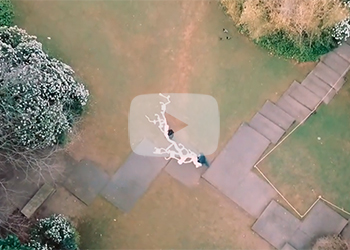The brain across all its dimensions

The title is inspired on a poem by Emily Dickinson, “The brain is wider than the sky” in which the American poet also describes the human brain as “deeper than the sea” and “with the just weight of God”. It is this extraordinary complexity that the exhibition seeks to celebrate across its multiple representations in science, the arts and philosophy. Each one of the three thematic sections composing this exhibition develops a fundamental concept and sets out factual information on the prevailing state of knowledge in the neurosciences through broadly interactive means and with multiple windows opening onto the human mind.
The entrance, an immersive experience of the human brain, generating a major sensorial and emotional impact, awaits the visitor: a voyage suggested by a video installation with an original soundtrack composed by Rodrigo Leão and with images from the work Self-reflected by the American artist and neuroscientist Greg Dunn.
In the beginning, there were no brains
The first module discusses the origins of the brain as a process of biological evolution, presenting its complexity within the scope of this evolutionary continuum. This includes 3D models of brains of different vertebrates (fish, amphibians, reptiles, birds and mammals) and explains the way in which this organ receives sensorial information and executes motor programs. This module also includes a monumental sculpture of a neuron, reaching some 12 metres in length, suspended from the ceiling and LED illuminated to simulate neuronal flashes in reaction to the presence of visitors. In order to illustrate the role of the sensorial and motor cortex, there are available interactive motor and sensorial homunculi exhibits.
Thinking the brain
The second module has an Orchestra of Brains as its central piece, a multimedia installation in which four visitors may simultaneously visualise and hear their cerebral activities. The signals captured through a helmet are projected onto a large scale canvas; the translation of the sounds was undertaken by Rodrigo Leão. This module explains how the complexity of the brain gives rise to our mental experiences of the world around us as well as of our own selves – from memory to language, perceptions and emotions and, taking a chronological format, this presents various of the landmarks in the history of the brain as the biological foundation of the mind.
A painting by Bridget Riley, from the Gulbenkian Museum Modern Collection, illustrates how the main principles of perception behind optical illusions were incorporated into the OpArt artistic style. An interactive piece about animals that hold the capacity for vocal learning – one of the pillars of oral language in humans – comes in support of the section on language featured in this module.
Artificial minds
The final module focuses on the development of technology and how artificial intelligence and robotics replicate part of the complexity of the organisation of the brain. This demonstrates how cerebral activities may now be applied to control external devices and how such technology is now undergoing exploration in the biomedical context for patients with motor disabilities. Visitors get the chance to play Mindball, a mental game of football in which two players challenge each other through moving the ball towards the opponent’s goal by their cerebral brain waves.
There is also a series of various different interactive works on display such as a tablet application on the ethical dilemmas posed by self-driving cars. Robot painters by the artist Leonel Moura also go about their work in real time throughout the exhibition.
